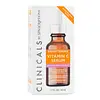What's inside
What's inside
 Key Ingredients
Key Ingredients

 Benefits
Benefits

 Concerns
Concerns

 Ingredients Side-by-side
Ingredients Side-by-side

Water
Skin ConditioningGlycerin
HumectantBifida Ferment Lysate
Skin ConditioningLactobacillus Ferment
Skin ConditioningButylene Glycol
HumectantPropylene Glycol
HumectantSodium Lactate
BufferingCarbomer
Emulsion StabilisingArginine
MaskingNiacinamide
SmoothingLactic Acid
BufferingPEG-40 Hydrogenated Castor Oil
EmulsifyingRhamnose
HumectantHydroxyethylcellulose
Emulsion StabilisingChlorphenesin
AntimicrobialAscorbic Acid
AntioxidantPhospholipids
Skin ConditioningGlycolic Acid
BufferingRetinol
Skin ConditioningAdenosine
Skin ConditioningCaprylhydroxamic Acid
Xanthan Gum
EmulsifyingEthylhexylglycerin
Skin ConditioningFerulic Acid
AntimicrobialSqualane
Emollient1,2-Hexanediol
Skin ConditioningBetaine
HumectantPhenoxyethanol
PreservativeWater, Glycerin, Bifida Ferment Lysate, Lactobacillus Ferment, Butylene Glycol, Propylene Glycol, Sodium Lactate, Carbomer, Arginine, Niacinamide, Lactic Acid, PEG-40 Hydrogenated Castor Oil, Rhamnose, Hydroxyethylcellulose, Chlorphenesin, Ascorbic Acid, Phospholipids, Glycolic Acid, Retinol, Adenosine, Caprylhydroxamic Acid, Xanthan Gum, Ethylhexylglycerin, Ferulic Acid, Squalane, 1,2-Hexanediol, Betaine, Phenoxyethanol
Zinc Oxide 17.5%
Cosmetic ColorantWater
Skin ConditioningCaprylic/Capric Triglyceride
MaskingGlycerin
HumectantMethyl Dihydroabietate
Cetearyl Alcohol
EmollientCetyl Palmitate
EmollientCoco-Glucoside
CleansingCaprylyl/Capryl Glucoside
CleansingSorbitan Palmitate
EmulsifyingSorbitan Olivate
EmulsifyingButyrospermum Parkii Nut Extract
EmollientEthyl Ferulate
AntioxidantBisabolol
MaskingAllantoin
Skin ConditioningHydrolyzed Jojoba Esters
Skin ConditioningAcacia Senegal Gum
MaskingPolyhydroxystearic Acid
EmulsifyingPolyglyceryl-3 Polyricinoleate
EmulsifyingIsostearic Acid
CleansingLecithin
EmollientTocopheryl Acetate
AntioxidantTetrahexyldecyl Ascorbate
AntioxidantDecapeptide-52
Skin ConditioningOryza Sativa Starch
AbsorbentCamellia Sinensis Leaf Extract
AntimicrobialEuterpe Oleracea Fruit Extract
Caesalpinia Spinosa Fruit Pod Extract
Helianthus Annuus Sprout Extract
Skin ConditioningCaprylyl Glycol
EmollientEthylhexylglycerin
Skin ConditioningHexylene Glycol
EmulsifyingXanthan Gum
EmulsifyingSodium Phytate
Propylene Glycol
HumectantPhenoxyethanol
PreservativeSodium Benzoate
MaskingPotassium Sorbate
PreservativeZinc Oxide 17.5%, Water, Caprylic/Capric Triglyceride, Glycerin, Methyl Dihydroabietate, Cetearyl Alcohol, Cetyl Palmitate, Coco-Glucoside, Caprylyl/Capryl Glucoside, Sorbitan Palmitate, Sorbitan Olivate, Butyrospermum Parkii Nut Extract, Ethyl Ferulate, Bisabolol, Allantoin, Hydrolyzed Jojoba Esters, Acacia Senegal Gum, Polyhydroxystearic Acid, Polyglyceryl-3 Polyricinoleate, Isostearic Acid, Lecithin, Tocopheryl Acetate, Tetrahexyldecyl Ascorbate, Decapeptide-52, Oryza Sativa Starch, Camellia Sinensis Leaf Extract, Euterpe Oleracea Fruit Extract, Caesalpinia Spinosa Fruit Pod Extract, Helianthus Annuus Sprout Extract, Caprylyl Glycol, Ethylhexylglycerin, Hexylene Glycol, Xanthan Gum, Sodium Phytate, Propylene Glycol, Phenoxyethanol, Sodium Benzoate, Potassium Sorbate
Ingredients Explained
These ingredients are found in both products.
Ingredients higher up in an ingredient list are typically present in a larger amount.
Ethylhexylglycerin (we can't pronounce this either) is commonly used as a preservative and skin softener. It is derived from glyceryl.
You might see Ethylhexylglycerin often paired with other preservatives such as phenoxyethanol. Ethylhexylglycerin has been found to increase the effectiveness of these other preservatives.
Glycerin is already naturally found in your skin. It helps moisturize and protect your skin.
A study from 2016 found glycerin to be more effective as a humectant than AHAs and hyaluronic acid.
As a humectant, it helps the skin stay hydrated by pulling moisture to your skin. The low molecular weight of glycerin allows it to pull moisture into the deeper layers of your skin.
Hydrated skin improves your skin barrier; Your skin barrier helps protect against irritants and bacteria.
Glycerin has also been found to have antimicrobial and antiviral properties. Due to these properties, glycerin is often used in wound and burn treatments.
In cosmetics, glycerin is usually derived from plants such as soybean or palm. However, it can also be sourced from animals, such as tallow or animal fat.
This ingredient is organic, colorless, odorless, and non-toxic.
Glycerin is the name for this ingredient in American English. British English uses Glycerol/Glycerine.
Learn more about GlycerinPhenoxyethanol is a preservative that has germicide, antimicrobial, and aromatic properties. Studies show that phenoxyethanol can prevent microbial growth. By itself, it has a scent that is similar to that of a rose.
It's often used in formulations along with Caprylyl Glycol to preserve the shelf life of products.
Propylene Glycol is an odorless, colorless liquid. As a humectant, it helps skin retain moisture. It also aids in delivering active ingredients.
Another role of this ingredient is preventing a product from melting or freezing. Propylene glycol also adds antimicrobrial properties to a product, elongating product lifespan.
This ingredient is considered an organic alcohol and commonly added into both cosmetics and foods.
Those with sensitive skin or conditions may develop a rash when using this ingredient.
Learn more about Propylene GlycolWater. It's the most common cosmetic ingredient of all. You'll usually see it at the top of ingredient lists, meaning that it makes up the largest part of the product.
So why is it so popular? Water most often acts as a solvent - this means that it helps dissolve other ingredients into the formulation.
You'll also recognize water as that liquid we all need to stay alive. If you see this, drink a glass of water. Stay hydrated!
Learn more about WaterXanthan gum is used as a stabilizer and thickener within cosmetic products. It helps give products a sticky, thick feeling - preventing them from being too runny.
On the technical side of things, xanthan gum is a polysaccharide - a combination consisting of multiple sugar molecules bonded together.
Xanthan gum is a pretty common and great ingredient. It is a natural, non-toxic, non-irritating ingredient that is also commonly used in food products.
Learn more about Xanthan Gum